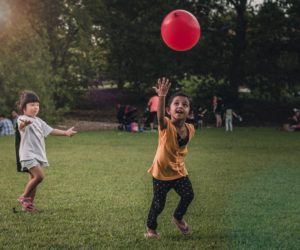Activities for Social Skills in Children
Many families are intersted in how they can support their children to connect, play and participate in their social environments.
Communication is an inherently social act! As people, we talk, share, relate and engage with each other in a variety of different ways.
When thinking about ‘Social Skills’ – there is a key idea we need to emphasise…
All brains are different!
Neurodiversity is the understanding that all brains see, perceive and think about the world in ways that are different, and that one way of seeing, viewing or perceiving the world isn’t better than another.
So.. what does this have to do with social skills?
Well, commonly for children who are neurodivergent, ‘social skills’ are a goal or target in therapy.
A neuro-affirming approach to practice would advocate rather to understand that there is a difference between ‘Neurotypical’ Social Communication, and Neurodivergent Social Communication.

What this means is.. children who are Autistic, ADHD, AudHD (Autisitc + ADHD), Dyslexic, or have another Neurodevelopmental difference should not be expected to see, perceive, think and respond to the world around them, in a way that people who are Neurotypical consider ‘normal’.
In fact, teaching social skills based on an idea of what is ‘normal’ can lead to negative impacts for individuals who are neurodivergent, particularly in relation to their self identity, confidence and mental health.
Individuals who are neurodivergent commonly report that they have been taught to ‘mask’ their preferences, individual style, and ways of communicating in order to be accepted, or conform to the ‘rules’ that neurotypical people expect.
So.. what do we do? Should we still support, or teach social skills?
Well, it is true that a person’s social skills are one method by which they communicate and engage with other people, and parents do have an important role to play!
It’s also true that each person will have their own differences, perceptions and beliefs about the world, and ways of communicating and connecting with others.
But importantly – understanding, empathy and perspective taking needs to go both ways. It is inappropriate to ‘teach’ neurodivergent children ‘rules’ or social standards that require them to inhibit or mask their unique creativity and expression in the world.

What we can support is skills related to:
- Self Advocacy – does a child have the language skills to explain their needs, wants and perspectives, particularly in relation to their own or others communication styles? This links importantly with self identity, and the ability to have self confidence and navigate the world.
- Self Regulation – for all children, learning to understand, acknowledge and respond to the world using strategies for self-regulation is essential, not just for children who are neurodivergent, or have different sensory preferences.
- Empathy & Perspective Taking – again, this area needs to be taught to all children and families, not just children who are neurodivergent. In fact, in many cases helping a child’s friends understand and embrace diversity and difference will be more effective than trying to teach a neurodivergent child to change themselves and their communication preferences.
What about social communication specific skill teaching?
Supporting neurodivergent children to understand more about themselves, the world around them, and helping them identify and utilise different communication skills has a place … if..
This is a goal identified by that child or young person. Because…
They are wanting to improve their own skillset, in relating to neurotypical peers.
Not..
Because their parents want them to, or their teachers think it is important.
Whilst this might be an unpopular opinion for neurotypical parents and educators, it is increasing reported by adult autistics and AudHDers that the process of therapy, experience of being taught to mask to ‘fit in’, and the lack of understanding and acceptance of difference in social communication preferences is a major area in which we need to change, and advocate for change, particularly in the world of providing therapy to kids.
Importantly, the idea is to put the perspective of the child or young neurodivergent person first – to be responsive to their experience of the world, and support the development of skills that allow them to connect authentically and genuinely with the world around them.
Additionally, to embrace diversity, celebrate difference, and provide environmental supports or adjustments that make it easier for neurodivergent children to participate in social activities and educational experiences that they enjoy.
So.. what can families do at home?
Well, below are some recommendations written to support genuine & authentic social connection with your neurodivergent or neurotypical child or young person.
Have a Conversation
It is important to connect with our young ones in an authentic and genuine manner. When playing and/or talking with your child, ask them open-ended questions to encourage extended utterances (using further wh-questions to prompt for more information).
Make a lot of comments about what you are doing, and pause to allow your child to provide their own input. Make sure the conversation is fun and enjoyable for the child by balancing questions and comments, and accepting their ideas.
Allow space for children who are neurodivergent to share their ideas, passions, and elaborate on these in ways that feel meaningful for them.
Acknowledge Emotions
When reading a book, watching a movie, or playing with your child, label the emotions the characters are feeling and explain why they may be feeling this way. This helps the child to understand that different actions and events can lead to different emotions. Explicitly teaching this is helpful for children of all neurotypes to begin to understand each person’s unique perspective on the world.
Ensure you also take time to explain the different perspectives of people if multiple characters respond differently to one event. This will help your child to learn that different people can have different thoughts and feelings.
Emotions are part of our see – perceive – think – respond cycle, and using natural opportunities that are meaningful to your child to make this process explicit is really helpful in building emotional intelligence skills early.
Encourage Guessing
It is important to encourage children to ‘have a guess’ when they don’t know something, as this builds inferencing skills (important for social interactions).
You can do this through book reading with your child, asking them what they think might happen next, or what characters might do after an event. When your child asks a ‘why’ question, you can ask them to have a guess first before you respond.
Problem-Solve Together
Having the ability to problem-solve with other individuals is very important when trying to build/maintain friendships with others. You can do this by engaging your child in a rule-based game, such as card games and board games. Negotiate with your child what rules the game has, and how the players must play the game.
Most of all – have fun! The goal of social communication is simply to enjoy the connection we have with children. Make this connection the #1 focus, and enjoy the relationship that is developing. Embrace diversity in style and engage your own empathy to understand and respect the differences in perspectives that each person brings to an interaction.


Originally written by Thida Hantun, 2023, editing provided by Marion Giddy to update in 2024.
Speech Pathologists

